Art and Crafting History: Quilting
Document Presets
To download, choose the "Save as PDF" option when asked to choose a printer.
Primary Source Set
Art and Crafting History: Quilting
Quilting is a practice of both art and practical skill. Quilts have been used to warm loved ones, display artful technique, and stitch together stories and memories. What we see as an everyday craft uncovers social conditions and lived experiences of those who invested their time into their quilting. Through this, we can catch a better glimpse of the lives of North Carolinians past and present.
Please proceed with caution and care through these materials as a few sources may be difficult to review. Particularly, there are sources and context statements that discuss the history of slavery and exploitation of Black and African-American people, as well as the genocide of indigenous people. There are also materials and context statements addressing gender oppression, misogyny, and the AIDS epidemic. Please read DigitalNC’s Harmful Content statement for further guidance.
Time Period
1897-2022
Selected Sources
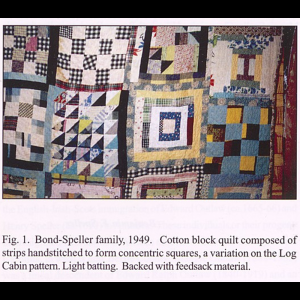
African American Family Quilts of Bertie County, N.C.
Bertie County, NC (Bertie County), 2003
This image is pulled from an exhibition catalog on quilts from African-American families in Bertie County at the Historic Hope Plantation. In the full resource, which is accessible through this link, the history of the African-American quilting tradition is explained and other quilts are pictured. This particular quilt shows the history of patchwork design and the common use of asymmetry in African-American quilts. Sometimes required to create quilts for their enslavers, enslaved women also created quilts for themselves and the people they cared for. They would use both patchwork and applique techniques, which have commonalities with African textile traditions. Quilting continued to be a practice of both practicality and artistry in Black and African-American communities.
Contributed to DigitalNC by Historic Hope Plantation
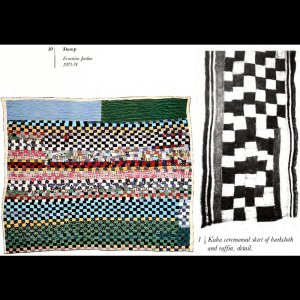
Models in the Mind: African Prototypes in American Patchwork
Greensboro, NC (Guilford County), 1992
Pictured (left) is a multicolored quilt with many tiny asymmetrical squares, which was part of the exhibition program presented at the Diggs Gallery at Winston-Salem University. The author of the program connects this quilt to African traditions with textiles and weaving. It is related to patterns in Hausa and Kuba traditions, one of the Kuba ceremonial skirts also pictured (right). Throughout the rest of the full primary source, available through this link, the author challenges the simple narrative of many American quilting patterns being traceable to European traditions alone. They showed connections between patterns like the Log Cabin to African design, questioning how little the influence of African design is recognized in American quilting. Black and African American quilting spaces have been sources of community building and activism, using quilts to share stories and raise awareness to issues facing their community.
Contributed to DigitalNC by North Carolina Humanities Council
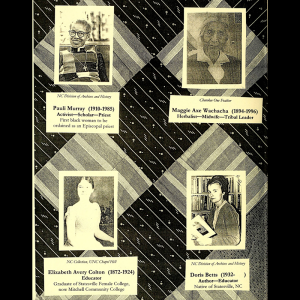
Patches and Patterns: Stitching Together NC Women's History
Statesville, NC (Iredell County), 2001
This quilt was created by Mitchell Community College’s Spring 2001 Women’s Studies Class. The project was sponsored by the college and the North Carolina Humanities Council. The students created a quilt with the help of an older quilter from the community, Lutelle Phillips, and used the quilt to tell a story of women’s history in North Carolina. Through their research, they identified people important to women’s history and displayed their photos and names on the quilt. This follows a tradition of African-American storytelling quilts, and shows how impactful this use of quilting can be. This section of their quilt shows four individuals: Pauli Murray, Maggie Axe Wachacha, Elizabeth Avery Colton, and Doris Betts. Murray was a prominent Black queer scholar and advocate, contributing to the legal argument for Brown. Board of Education. The Pauli Murray Center is dedicated to uplifting and continuing Murray’s work, as well as shedding light on Murray’s own complex relationship with gender. Given the Cherokee’s revered title “Beloved Woman,” Wachacha had served as a midwife, healer, and clerk of the Cherokee Tribal Council. Colton, a descendant of Confederate leader and enslaver William Waightstill Avery, taught at many colleges and universities (including Columbia University, Wellesley College, and now named Meredith College). She was a strong advocate for white women’s educational rights, and was a charter member for the Southern Association of College Women. Betts was a professor at the University of North Carolina at Chapel Hill and an award-winning author of short stories and novels, including “The Ugliest Pilgrim” and “The Beasts of the Southern Wilds.” She wrote in the Southern literary tradition and had a religious influence in her writing.
Contributed to DigitalNC by North Carolina Humanities Council

Rockingham County Bicentennial Quilt, 1776-1976
Rockingham County, NC (Rockingham County), 1976
Contributed by Rockingham County Public Library, this program shares information on the Rockingham County Bicentennial Quilt made to celebrate two hundred years of Rockingham County’s history. Quilting rose in popularity around the time of the bicentennial across the US. There are descriptions of each of the squares’ contributors and their quilt squares. The squares ranged from drawing inspiration from native dogwoods to the seal for the women’s nationalist organization the Daughters of the American Revolution. It also included revisions of history, like the “moving” of the Saura tribe; the county had once been part of Pee Dee, Saura/Cheraw, and Lumbee tribal lands, lines shifting during tribal conflicts and colonization. Rockingham County includes the town of Reidsville, which is the location of the Chinqua-Penn Plantation and was featured as inspiration in the quilt, as well.
Contributed to DigitalNC by Rockingham County Public Library
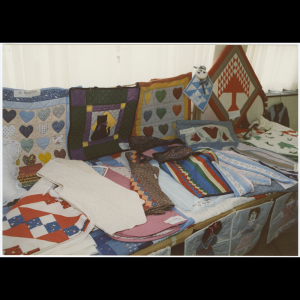
Johnston Community College Quilting Class
Smithfield, NC (Johnston County), 1987
This photo displays the quilting projects of a Johnston Community College quilting class. There are quilt squares, which is a technique some quilters use to create the “building blocks” for the top layer of their large quilts to make them easier to handle. A variety of techniques and influences can be seen in this collection of pieces, showing specifically some Black/African-American influence with the use of applique and the long thin strips of fabric quilted together.
Contributed to DigitalNC by Johnston Community College
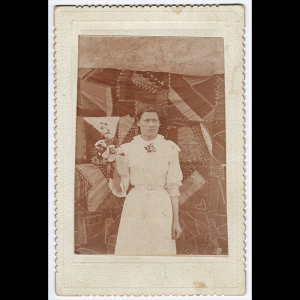
Addalissia Ann Ormand Goforth and Her Handmade Crazy Quilt
Cleveland County, NC (Cleveland County), 1897
This photo of Addalissia Ann Ormand Goforth circa 1897 is from the Kings Mountain Historical Museum. The photo’s description includes that “it is believed that this photograph was taken at a Cleveland County Fair or a Church Bazaar, where she won a “blue ribbon” prize for her quilt. The bouquet she is holding is probably for winning the prize.” Crazy quilts became a trend in the 1800’s after industrialization made the consumption of fabric more affordable and widespread. While many find it hard to pinpoint the exact creation of the first dubbed “crazy quilt,” many have cited the influence of the exhibit of a quilt by The Royal School of Needlework at the Japanese Pavilion during the Philadelphia Centennial, and attributing Asian and Middle Eastern influences.
Contributed to DigitalNC by Kings Mountain Historical Museum

Log Cabin Quilt
Orange County, NC (Orange County), 1900
This quilt is part of a collection of quilts with the Orange County Historical Museum. It is described as a log pattern quilt as it has a central square shape representing a hearth and strips of fabric around the central square to symbolize logs. The quilt is described as courthouse steps. The log cabin pattern has been controversially attributed to being used as guideposts along the Underground Railroad during the Civil War and sales of the log cabin quilts were a way to raise money for the Union army. The log cabin pattern has become a staple design in American patchwork.
Contributed to DigitalNC by Orange County Historical Museum
![Transylvania County Library Children's Department Scrapbook [1985-1988]](https://www.digitalnc.org/wp-content/uploads/2025/03/Transylvania-County-Library-Childrens-Department-Scrapbook-1985-1988-300x300.png)
Transylvania County Library Children's Department Scrapbook [1985-1988]
Transylvania County, NC (Transylvania County), 1986
Within this Transylvania County Library scrapbook, an article was saved showing a woman and her daughter showing off the quilts she had made for the children’s space in the library. Libraries and informational spaces in general have a history of using quilts to add sources of information and comfort to their spaces.
Contributed to DigitalNC by Transylvania County Library

Graham County Woman's Club dressed up for their 1972 "Quilting Bee"
Graham County, NC (Graham County), 1972
During the 1970’s, the Graham’s County Woman’s Club was one of many groups to formalize the trend of community gatherings to participate in quilting. This reflects the history of quilting as “women’s work” and the ways that many women used domestic duties to build community. Quilting bees picked up in North Carolina during the 19th century; then, the 1970’s saw a time of revival for many handcrafts, including quilting, and quilting bees likewise increased across the US. Later, some of these quilting bees and groups would grow into today’s quilt guilds that teach quilters and provide space to work and show off quilts to other enthusiasts.
Contributed to DigitalNC by Graham County Public Library, Nantahala Regional Library
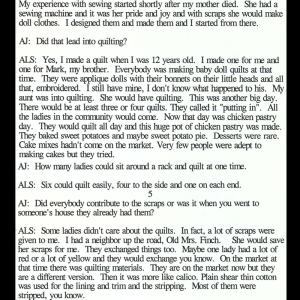
Agnes L. Stott Oral History Interview [March 04, 1996]
Nash County, NC (Nash County), 1996
Agnes Scott grew up in rural Nash County, and her oral history recounts rural life and her time farming. Nash County still has operating farms, though that number has been steadily decreasing over time. She shares memories of quilting, pointing out that many people would save scrap fabrics to give to others to make quilts or to trade for different colored fabric. While quilting has always been an art, it was also a practicality for many people. Textile manufacturing rose in North Carolina in the 1900’s and fabric became more readily available for most people, leading to repurposing fabrics, like feed sacks, into quilts.
Contributed to DigitalNC by Braswell Memorial Library (Rocky Mount, N.C.)

Glimpses of the Rural Carolinas
Madison County, NC (Madison County), 1992
Glimpses of the Rural Carolinas was created using photos by Rob Amberg who traveled through rural North and South Carolina to document the lives of people living in rural areas. They had accompanying narratives by different people, and Kathlyn Sullivan contributed to the quilting section of the book. This friendship quilt, given for a 40th birthday, is crafted in the crazy quilt style and was made in Madison County, NC. Friendship quilts were becoming an increasing practice in North Carolina communities around the beginning of the 20th century, being given to mark special occasions or as a farewell gift for community members that were moving away. Friendship quilts continued to be practiced in many communities, as shown here. It also evidences the strong quilting traditions found in Appalachian communities. As Appalachia began to rely on the tourism industry to boost the region’s economy, many quilters started selling their quilts and other crafts. Now, there are established “quilting trails” to view Appalachian quilts and established places to buy handcrafted quilts, as well as other folk crafts.
Contributed to DigitalNC by North Carolina Humanities Council
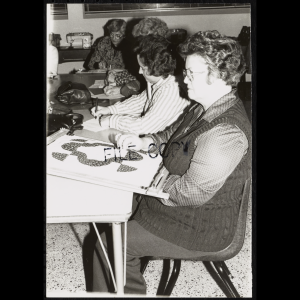
Quilting class
Sanford, NC (Lee County), 1980
Quilting takes both time and effort, but also space. Creating large blankets requires the quilter to handle a large piece of fabric as the quilt grows (as with patchwork quilts) or during the entire process, as in the case of using applique or stitch design techniques. Quilting frames have been used at least since the 14th century to make the process of quilting easier. In this photo, one of the quilters in the Central Carolina Technical College extension course on quilting is using a square quilt frame that allows the quilter to handle the quilt block by block. Used much like an embroidery hoop, this pulls the fabric taut and makes handling large and small projects easier.
Contributed to DigitalNC by Central Carolina Community College
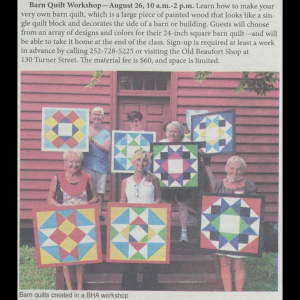
Pine Knoll shore-line. ([Pine Knoll Shores, North Carolina]) [8/1/2022]
Pine Knoll Shores, NC (Carteret County), 2022
Organized by the Beaufort Historical Association, this workshop advertised in the The Shore Line taught participants how to make their own barn quilts. In the photo, the barn quilts are shown; they look like large quilt squares with geometric quilt patterns painted on. Today, rural areas will use ‘barn quilt trails’ to increase tourism in these areas, like these North Carolina barn quilt tours.
Contributed to DigitalNC by History Committee of the Town of Pine Knoll Shores

Q-notes. (Charlotte [N.C.]) [9/6/2008]
Asheville, NC (Buncombe County), 2008
This issue of Q-notes provides an update on a world renown quilt, the AIDS Memorial Quilt, which first debuted in 1987 during the 1987 March on Washington. The quilt at the time of the article had over 47,000 panels representing people who died due to the AIDS epidemic. The quilt also travelled in portions to be displayed in various places; the article notes that family members and friends of Western North Carolinians whose names were included in the quilt could request their panels to be displayed at Western North Carolina AIDS Project’s memorial exhibit. This is one example of how quilts have been used as a form of protest and memorial. The quilt now contains over 50,000 names and is stewarded by the National AIDS Memorial, where the quilt can be viewed in its entirety, including the panels contributed by people in North Carolina.
Contributed to DigitalNC by University of North Carolina at Charlotte
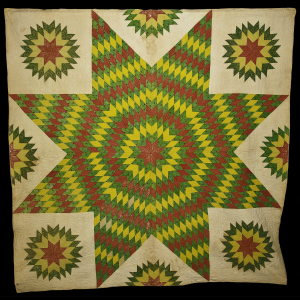
Star Pattern Quilt
Orange County, NC (Orange County), 1861
This quilt was made by Elizabeth Vincent Berry and shows the Star Pattern, thought to have been developed in England before appearing elsewhere. The star pattern was influenced later by many indigenous quilters, calling the pattern the Morning Star. Quilts were used in ceremonial and traditional clothing and used as gifts to mark important occasions and relationships. In North Carolina, Lumbee tribe member Maggie Lowrie Locklear created her own design, the Pinecone Patchwork pattern, which heavily influenced Lumbee quilting tradition and can be seen in a revival of cultural dress.
Contributed to DigitalNC by Orange County Historical Museum
Background
Quilting is the process of creating textile-based materials (e.g. blankets, clothing, etc.) and is distinguished by its use of three layers: a top layer of fabric, some type of internal batting (insulating fibrous material), and a back layer of fabric. Techniques include applique, where fabric designs are stitched onto the top layer of fabric; stitch design, where the three layers are stitched together so that the stitching creates designs on the quilt; and patchwork, where pieces of fabric are stitched together to form the top layer of fabric.
This craft has been adopted by many cultures for its practical usage and as an artistic medium. Some of the earliest examples of quilting date back to the 35th century BC, evidenced in a carving of a pharaoh wearing a quilted garment. Other early examples are Mongolian quilted coverings from 200 AD and quilted cushioning for armor worn by Turkish soldiers circa the 11th century. After being exposed to the practice during the crusades, many European cultures began their own quilting practices.
It is difficult to prove if indigenous people created quilts within what is now called the United States (US) before colonization. However, there are many examples of indigenous styles of quilting after the arrival of European settlers. Indigenous people used quilting to display cultural symbols, like the Morning Star, and build community.
Over 10 million African and Black people were enslaved in the US by the 1860’s. There is evidence that many African traditions had men as the textile creators; however, slavery imposed Western gender roles onto those who were enslaved. Though women who were enslavers also continued to quilt during this time, enslaved women were tasked with creating quilts for the family that enslaved them; this is one example of how artistic labor was exploited under slavery.
From this, many African-American and Black women began their own practices of quilting. Though they typically used the patchwork style to piece together fabric scraps into a quilt, applique techniques, a technique where a piece of fabric is stitched onto the top of the top layer of fabric, were also used as a call back to African textile designs. Patchwork quilting would later be taken up by many poor and working class people as a way to make use of fabric scraps, both for the top layer of fabric and the internal batting of quilts. Patchwork styles are extremely varied.
Quilting was especially important in colder climates, like the Appalachian region of western North Carolina. Functionality gave way to artistry as people were influenced by other traditions and created their own styles of quilting. Quilting became an avenue for community through group quilting sessions and collaborative quilts to gift to community members; it also became a revenue stream as tourism increased and handicrafts became popular souvenirs.
Today, people continue to practice quilting to connect with others and develop useful skills. People have adopted the love of quilting in many different ways, like with barn quilts, referring to the painting of large squares to resemble quilt patterns that would be hung on the outside of barns. Quilts can tell the stories of communities and relationships between people. They can represent a connection to one’s cultural heritage as much as a way to practically keep oneself warm. This primary source set explores the various relationships between people and the art of quilting as a way to understand the lives, experiences, and realities of North Carolinians throughout history.
Discussion Questions
Quilting Influences
- Review the sources on Black and African-American quilting traditions: African American Family Quilts of Bertie County, N.C. and Models in the Mind: African Prototypes in American Patchwork.
- In what ways and for what purposes has quilting been used by Black and African-American people?*
- Why might people use arts and crafts in these ways?**
- How have you seen people use quilting in similar ways?**
- In what ways and for what purposes has quilting been used by Black and African-American people?*
- Study the Star Pattern quilt and notice the design elements, including pattern and color choices. Use outside research on the design as is helpful.
- What are the elements present in the quilt?*
- What influences can be seen in these elements?**
- For the star pattern, what influences may have contributed to the development of this pattern?**
- How might influences have impacted the design over time?**
- What new meanings have become attached to the design?**
- What are the elements present in the quilt?*
- Review the sources on Black and African-American quilting traditions: African American Family Quilts of Bertie County, N.C. and Models in the Mind: African Prototypes in American Patchwork.
Quilting and Community
- Consider the collection of primary sources in this set.
- What sources show instances of community through quilting?*
- What communities are represented in these sources?*
- What communities are not represented within the sources?*
- What can quilting tell you about life in North Carolina?*
- What sources show instances of community through quilting?*
- Review the Glimpses of Rural Carolina excerpt.
- What is a friendship quilt and how were they created?*
- How did this build community ties?*
- Are there ways that traditions like this can be passed on or incorporated into other communities?*
- Is this a practice that you could imagine becoming important to communities you are a part of?**
- Look at the article from Q-Notes on the AIDS memorial quilt.
- How was this quilting project used to build community?*
- How did this quilt bring together people from different communities?*
- How was this quilt used for social change?*
- What other instances of quilts being used for social change can you identify either in the primary sources, your knowledge, or research?**
- How can different values or ideologies be expressed through quilting?**
- How was this quilting project used to build community?*
- Consider the collection of primary sources in this set.
History Quilts
- Review the Rockingham Bicentennial Quilt program for information on the history quilt.
- What histories are represented in the quilt?*
- What histories are not represented in the quilt?**
- How is the power of narrative shown in this history quilt?**
- What does this quilt tell you about the perspectives on history of the quilters that contributed to this history quilt?**
- What histories are represented in the quilt?*
- Now contrast this with the history quilt from Mitchell Community College’s Women’s Studies History Quilt.
- What histories are represented in this quilt?*
- What histories are not shown through this history quilt?**
- What message were the quilters trying to convey through this women’s history quilt?**
- What might their perspectives be on history and women’s history in particular?**
- How does this quilt differ from the Rockingham Bicentennial Quilt?**
- How are they similar?**
- What histories are represented in this quilt?*
* Questions that check for comprehension
** Questions that involve a “deeper dive” in conceptual and historical analysis
- Review the Rockingham Bicentennial Quilt program for information on the history quilt.
These materials were compiled by cal caughron. Updated May 2025.
https://www.digitalnc.org/primary-source-sets/art-and-crafting-history-quilting/
This document was prepared for print on September 18, 2025.